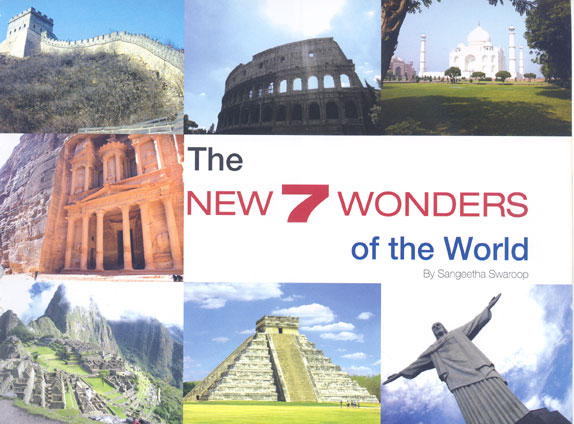
Amidst controversies and eager public participation, the New7Wonders of the
World competition launched in 1999 that saw voting processes begin as early as
2005, and attracting more than 100 million votes cast worldwide, came to an
end on the historic date of 07.07.2007.
The contest was organised by the New7Wonders Foundation
- the brainchild of Swiss filmmaker and museum curator Bernard Weber - in
order to “protect humankind’s heritage across the globe.” From nearly 200
nominations that came in from around the world, the list was narrowed down to
21 and on July 7, 2007, the New7Wonders of the World were announced during the
Official Declaration ceremony held at Lisbon, Portugal.
The 7 Wonders were chosen because the original list of Ancient Wonders, drawn
up more than 2,000 years ago, contained 7 and because 7 has been shown time
and again to be the number of things that the average person can remember.
What is intriguing here is that the New7Wonders of the World cover the whole
span of human history, from the earliest time that Man began to make his mark
upon the Earth, to the year 2000 A.D. So what where the criteria in
determining which monuments could be nominated to fit the description of a
‘wonder of the world’?
Structural quality was an essential factor and it was stipulated that all
monuments and buildings must be human-built and in an acceptable state of
preservation. This meant that the hand of Man must have been involved in the
fashioning of the monument or building and it was also essential that the
originators’ vision could still be perceived without artificial aids.
Artistic and cultural value of monuments and buildings were also noted, as was
their universal recognition. Eventually, only 21 nominations from 21 countries
were selected as finalists and only one finalist nomination was allowed per
country.
The New 7 Wonders are all equal – there is no rank among the list. The
New7Wonders of the World, as announced in random order at the Official
Declaration Ceremony on 07.07.07 are: The Great Wall of China, Petra, Chichén
Itzá, the Statue of Christ Redeemer, the Colosseum, Machu Picchu and the Taj
Mahal.
The Pyramids of Giza also were honored by the New7Wonders project as the only
remaining of the 7 Ancient Wonders of the World.

Petra, Jordan
The only Middle Eastern entry, this ancient rock city in present-day Jordan is
known to the Arabs as Wadi Mousa for the stream that flows through it.
Perched on the edge of the Arabian Desert, Petra was the capital of the
Nabataean kingdom of King Aretas IV (9 B.C. to A.D. 40). Masters of water
technology, the Nabataeans provided their city with great tunnel constructions
and water chambers that carried drinking water into the city and reduced the
chance of flash floods. A theater, modelled on Greek-Roman prototypes, had
space for an audience of 4,000.
Today, the Palace Tombs of Petra, with the 42-meter-high Hellenistic temple
facade on the El-Deir Monastery, are impressive examples of Middle Eastern
culture. The desert site includes some 800 structures, the best known of which
is the Khazneh Al-Farun (or Pharaoh’s Treasury), a mausoleum with a two-storey
façade and Hellenistic split pediment.
For many centuries the city of Petra was the focal point of a vast caravan
trade. Control of key trade routes brought Petra its fortune and produced
monumental temples, tombs and administrative buildings. After the Romans
annexed Petra in 106, its position as a commercial hub slowly weakened.
The city may have housed 20,000 to 30,000 people during its hey day under the
Romans, but by the end of he Byzantine Empire (circa 700 AD), the hydraulic
system and once-gracious buildings were almost ruins. For the following
centuries, Petra disappeared from most maps and became a legend. It was
unknown to the Western world until 1812 when Swiss explorer Johann Burckhardt
snuck into the city disguised as a Muslim and shared his discovery with the
rest of the world.
Petra, which means ‘stone’ in Greek, has survived through the ages because
almost all of its ‘buildings’ were carved out of solid rock walls. It is
perhaps the most spectacular ancient city remaining in the modern world.
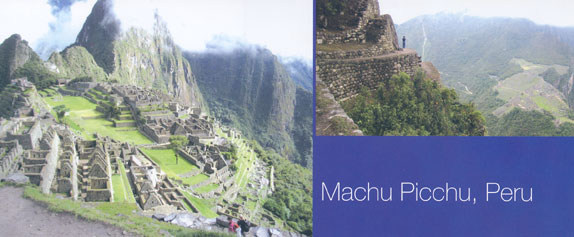
Machu Picchu, Peru
One of three successful candidates from Latin America, Machu Picchu is a
15th-century mountain settlement in the Amazon region of Peru.
Around 1440, it is believed that Pachacutec Yupanqui, the founder of the Inca
Empire, built the city in the clouds known as Machu Picchu (‘old mountain’) in
what is now Peru. This extraordinary settlement lies 7,710 ft above sea level,
deep in the Amazon jungle above the Urubamba River.
Forgotten for centuries by the outside world, Machu Picchu attracted
international attention when it was rediscovered by American archaeologist
Hiram Bingham in 1911. There are several different theories as to what Machu
Picchu was: some believe it was the luxurious mausoleum (burial site) of
Pachacutec, since there are remains of buildings that were covered with gold;
others think that it was an Incan ‘Ilata,’ a settlement built to both control
the economy of the conquered regions and to protect the top Incan aristocracy
in the case of an attack.
Another theory expands on this idea, seeing Machu Picchu as a country retreat
for the Inca nobility. It may also have been used as an observatory and for
astrological ceremonies. A maximum of 750 people probably lived in the ‘Lost
City of the Incas’ at once. It is said that the silhouette of the mountain
range behind Machu Picchu represents the face of the Inca looking upward
towards the sky, with the largest peak, Huayna Pichu (‘young mountain’),
representing his nose.
This ruined city is among the best known remnants of the Inca civilization,
which flourished in the Andes region of western South America. The city is
thought to have been abandoned following an outbreak of deadly smallpox, a
disease introduced in the 1500s by invading Spanish forces.
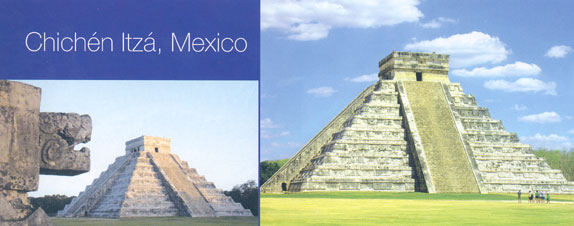
Chichén Itzá, Mexico
Chichén Itzá is possibly the most famous temple city of the Mayas, a
pre-Columbian civilization that lived in present day Central America. It was
the political and religious centre of Maya civilization during the period from
A.D. 750 to 1200.
While Europe was still in the midst of the Dark Ages, these amazing people had
mapped the heavens, evolved the only true writing system native to the
Americas and were masters of mathematics. Without metal tools, beasts of
burden or even the wheel they were able to construct vast cities across a huge
jungle landscape with an amazing degree of architectural perfection and
variety.
The Mayan name Chichén Itzá means “at the mouth of the well of the Itza
(people)”.
At the city’s heart lies the Temple of Kukulkan, which rises to a height of 79
feet (24 meters). Each of its four sides has 91 steps—one step for each day of
the year, with the 365th day represented by the platform on the top. The
construction of the Kukulcán Pyramid was planned so that each Vernal Equinox,
the dying sun would cast a shadow of a serpent writhing down the steps of the
pyramid, a phenomenon that attracts 40,000 people each year.
East of the major Chichén Itzá ruins is a dark underground world the Mayans
called Cenoté. These are deep water filled sinkholes formed by water
percolating through the soft limestone above. Since the porous soil held
little water, these underground bodies were extremely important to the city.

Statue of Christ the Redeemer, Brazil
This statue of Jesus stands some 38 metres tall, atop the 710-metre Corcovado
Mountain overlooking Rio de Janeiro. Designed by Brazilian Heitor da Silva
Costa and created by French sculptor Paul Landowski, the statue took five
years to construct and was inaugurated on October 12, 1931. It has become a
symbol of the city and of the warmth of the Brazilian people, who receive
visitors with open arms.
The span from fingertip to fingertip is 28m and there is a small chapel housed
in the base. As a vantage point it offers superb views of downtown Rio de
Janeiro, the bay, Sugarloaf Mountain and Copacabana and Ipanema Beaches.
The Statue of Christ the Redeemer history started in the 16th century when the
Portuguese named the mountain Pináculo da Tentação (The Pinnacle of
Temptation), alluding to the Biblical Mountain. A century later, the mountain
was re-baptised to Corcovado, a name derived from its form, which resembles a
hump or hunchback. In 1924, the first official expedition to Corcovado
Mountain resulted in the opening of an accessible way up.
In 1859, a Vincentian father Pedro Maria Boss arrived at Rio de Janeiro and
was struck by the mysterious beauty of the Corcovado Mountain and suggested
the construction of a religious monument in honour of Princess Isabel, which
in 1921 gave way for the idea of a great statue of Christ viewable by all in
the marvelous city of Rio.

The Colosseum, Rome, Italy
The only finalist from Europe to make it into the top seven—the Colosseum in
Rome, Italy, once held up to 50,000 spectators who came to watch gory games
involving gladiators, wild animals, and prisoners.
This great amphitheatre in the centre of Rome was built to give favours to
successful legionnaires and to celebrate the glory of the Roman Empire. Its
design concept still stands to this very day, and virtually every modern
sports stadium some 2,000 years later still bears the irresistible imprint of
the Colosseum’s original design.
The Colosseum’s name is believed to come from a colossus (130ft statue) of
Nero nearby, which was changed by Nero’s successors into a statue of Sol or
Apollo, the sun god. At some time during the Middle Ages, the statue
disappeared.
The Colosseum is 48 metres high, 188 metres long and 156 metres wide. There
are 80 arches on each of the first three levels. Its elliptical shape kept the
players from retreating to a corner, and let the spectators be closer to the
action than in a circle.
The Colosseum was cleverly designed with seating divided into sections: the
podium or first level was for Roman senators. Above it was designated for
other Roman aristocrats. The third level had three sections: a lower part for
wealthy citizens, an upper part for poor ones and a standing room area for
lower class women.
There are also tunnels, still in existence, made to flood and evacuate water
from the Colosseum floor so naval battles could be staged. An innovative
cooling system was designed to provide breeze for the audience. The Colosseum
was in use until 217 when it was damaged by fire from lightning.
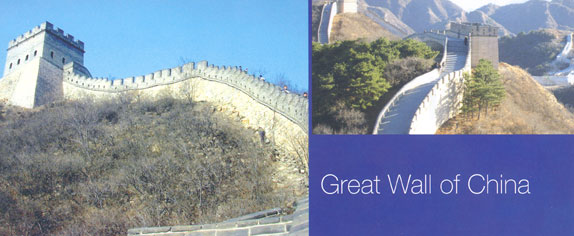
Great Wall of China
This newly elected world wonder was built along China’s northern border over
many centuries to link existing fortifications into a united defense system
and better keep invading Mongol tribes out of China. Constructed between the
fifth century B.C. and the 16th century, the Great Wall is the world’s longest
human-made structure, stretching some 6,400 kilometres.
Like a huge dragon, the Great Wall winds across plateaus, deserts, grasslands
and mountains from East to West. It began as independent walls for different
states when it was first built, and did not become the “Great” wall until the
Qin Dynasty. Emperor Qin Shi Huang succeeded in his efforts to have the walls
joined together to fend off invasions from the north after China’s
unification. However, the advantages of the enormous barrier faded with the
arrival of gunpowder and other weaponry.
The wall was originally built of stone, wood, grass and earth. Later, in the
Ming Dynasty, bricks were produced in kilns set up along the wall. Stories
abound about the many thousands of people who have given their lives to build
this colossal construction.
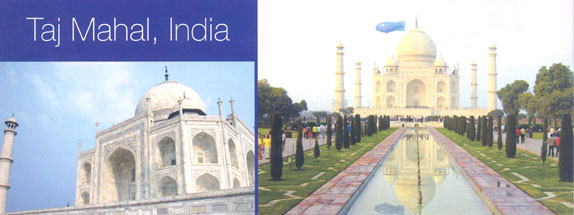
Taj Mahal, India
The Taj Mahal is regarded as the most perfect jewel of Mughal art in India.
This spectacular mausoleum in Agra was built by the Mughal Emperor Shah Jahan
to honour the memory of his beloved late wife, Mumtaz Mahal. Her last wish to
her husband was ‘to build a tomb in her memory such as the world had never
seen before’. Thus, he set about building this fairytale-like marvel of white
marble, surrounded by formally laid-out walled gardens.
Construction began in 1631 and took about 17 years to complete with some
20,000 workmen employed on it daily. The opulent, domed mausoleum, was built
with a total of 28 beautiful stones: red sandstone from nearby Fatehpur Sikri;
jasper from Punjab; jade and crystal from China; turquoise from Tibet; lapis
lazuli and sapphire from Sri Lanka; coal and cornelian from Arabia; diamonds
from Panna and the luminescent white marble from Rajasthan. Nearly every
surface of the entire complex has been decorated and the mausoleum includes
four minarets, each more than 13 storeys tall.
The composition of the forms and lines of the Taj Mahal is perfectly
symmetrical. The colossal height of the tomb, along with its pyramidal
appearance, fill it with grace making it seem to float or soar.
Shah Jahan was deposed and put under house arrest by one of his sons soon
after the Taj Mahal’s completion. It is said that he spent the rest of his
days gazing at the Taj Mahal from his cell window. He was later buried in the
Taj next to his beloved wife.